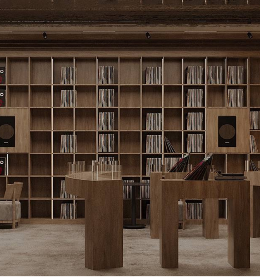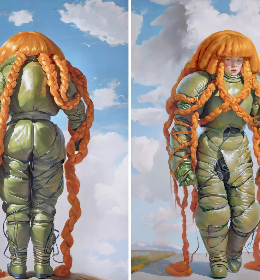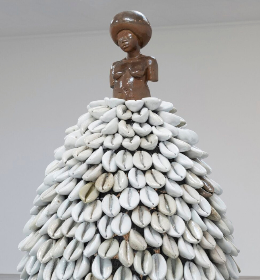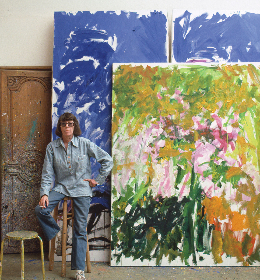Condo is an event developed by a number of London-based gallerists in which local participants host galleries from different cities in their spaces for a short period, allowing them to exhibit in London at minimal costs. The exhibitions are scattered across the city in different gallery venues. The first show I visit is being hosted by Cork Street Galleries, a presently-unoccupied glass-front space; there is a sign in the window advertising the space for rental for art galleries, and another a little further along for the ‘Mayfair Masterpiece’ luxury apartments being built atop. I start thinking about property speculation and gentrification and it later becomes a kind of recurring motif throughout my gallery visits.
This is all relevant because the first piece you see when you enter the space is a spectacularly entertaining film by the New York collective DIS, entitled Obama Baroque, on the ubiquity of disengagement in the face of global crises generated by financial capitalism due to pop culture inertia. Obama Baroque is a short video that overlays the bones of the popular noughties TV show Gossip Girl and deliciously warps it with protagonist It-Girl Serena van der Woodsen as a ‘Socialite turned Socialist’ and the omniscient narrator outlining the simultaneity of the bailout plan for the subprime mortgage crisis, the election of Barack Obama, and the moment that 4 million Americans tuned into a TV show about the aspirational lifestyles of New York’s richest residents.
If property developers are engaging in speculative property practices, instrumentalising the art world to shift their luxury Mayfair apartments, then DIS uses their generous space to posit the following project: ‘as our homes, property, and bodies are offered up as collateral to the tyranny of financialization, it’s necessary to ask, “how did we get here?’”
Cork Street has always been something of a gallery district though, and the addition of new ones won't serve to inflate property prices in a way that serves to eradicate affordable housing. In fact, for a while the concern was that it would be the galleries that would be priced out of the area so that rich international buyers could turn it into a residential enclave.
But my next stop is Arcadia Missa, a gallery whose recent arrival in neighbouring Soho was a move explicitly motivated by concerns for gentrification. Having operated as a commercial space in Peckham for three years, owner Rózsa Farkas upped sticks in 2018 and set up shop on Brewer Street in a postage-stamp sized space, a fraction of the size of her previous gallery. It doesn’t matter though, Cajsa Von Zeipel’s sculpture series The Gossips, are just as powerful in the intimacy of the space. The four sculptures are variations and repetitions on the same bust of a woman; according to the artist, they play on ideas of the fear of women collectivizing. They distil an essentialised, exaggerated gendered form and gently disfigure it.
The changing cityscape of London has always seemed to move at a crazy pace. Speaking to a (French) friend recently who had just moved back to London after a year in Paris, she told me that some friends suggested sharing a taxi home from a bar one night, and when she said she was living in Peckham again she was met with raucous laughter and told that ‘Peckham was dead.’ These white, middle-class taxi-takers, born and raised in the Home Counties, are now living in Deptford. But I suppose my surprise is only a sign of my being out of touch - even the Guardian reported over a year ago in a strange dystopian tone that “Deptford has been regenerated.” While Farkas’ self-imposed displacement is noble, it would appear that the neighbourhood she so loved was destined to die an undignified death under what she calls the unrelenting compulsion to transform entire areas of London into one giant Boxpark.

Cajsa Von Zeipel, The Gossips — Arcadia Missa
As I leave Arcadia Missa there are a group of people stood with their smartphones pointed at the sky as the day is ending. I look behind me and see that pink clouds have sprung from a darkening sky. I laugh at the small congregation and then decide that the pink of the sky does look good against the Soho neons and I take my own photo. I round a corner and a flock of men in one of those deeply London smoking pens in front of a pub also have their phones tilted skywards. The world moves so rapidly, strange patterns of behaviour become naturalised so quickly. I round the corner and visit the show by Elaine Cameron-Weir staged by JTT at Sadie Coles, resigned to a back room of the sprawling gallery.
I take the tube to Bethnal Green and realise I will have to come back right the way I came to get home. The bitter London defector in me thinks that it’s a city too big for a citywide gallery tour. I then notice that there is only an hour left of the preview weekend and that I have only seen three of the 18 exhibition spaces. I dislike rushing shows, I make rash value judgements on works and end up hating everything because it can never be as good as the potential goodness of that which I will have missed.
In the halo-y darkness of the tower block-lined fringes of the city’s financial heart, I trudge down the A107 and see shows by Queer Thoughts and Felix Gaudlitz galleries at Maureen Paley, featuring artists Chelsea Culprit and Juliette Blightman respectively. Some of these bigger galleries have set up their invitees so as they look like they’re at an actual art fair — Condo is by-and-large an attempt to circumvent the hegemony of the art fair idea — with coffee tables for press releases and coconut water. I also visit Herald St gallery who are hosting Gordon Robichaux and Wilding Cran galleries. Someone has written in the guest book “that is ART”; it makes me smile.

Carlos/Ishikawa, Condo founders, are showing boychild and hosting Antenna Space with Xinyi Cheng and Chapter NY with Samuel Hindolo. I get lost behind the small parade of curry houses and snooker bars but then spot someone in a designer leather puffa jacket and effectively locate the gallery. The exhibition hangs together really nicely with a series of dark, sincere paintings by Cheng and a photo series runs seamlessly on from the previous work. The show ends with a series of graphite drawings by boychild that look like manually manipulated smoke signals or the soft scraped stains of intimacy.
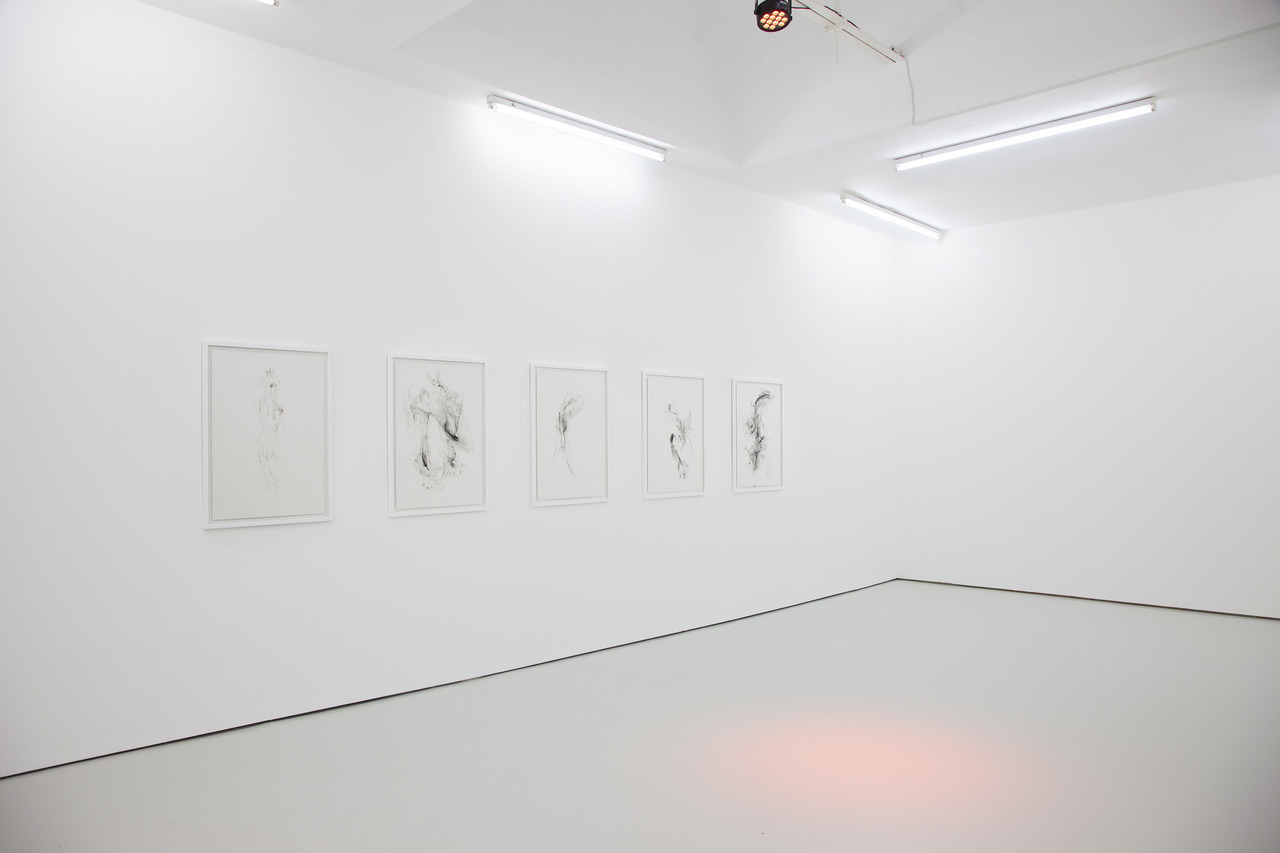
boychild, graphite on paper, 2018
It’s easy to be cynical about the arrival of art galleries in immigrant and working class neighbourhoods, to dismiss their presence as the vanguard of gentrification. But galleries are also at risk of predatory property practices and art fairs which threaten to close down anything that’s unbankable, leaving just the luxury flats in their wake. Within this paradigm, Condo is attempting to have a positive impact.
I ended the day so tired I walked into a Costa Coffee thinking it was the tube station. I’m sure this says something about the proliferation of corporate coffee shops as markers of gentrified changing urban landscapes and the homogenisation of globalisation, but I’m too tired to tell what.
Jessica Saxby





